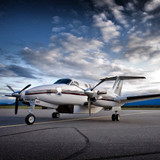By: Shannon Hope, Hope Aviation
sshope@hopeaviation.com
King Airs, whether a 200 flown by an owner-pilot or a 350, flown by a two-person professional crew, provide an impressively safe form of transportation – in some cases on a par with, and often safer than travel on a scheduled airline. Yet the risk of an accident – although very low – must be considered.
A corporation’s CFO, Risk Manager, Pilot or Owner must recognize and defend the catastrophic loss exposure a business aircraft like a King Air represents. It is imperative they examine, and become familiar with available insurance protection and risk management strategies. Fortunately large liability coverage limits are readily available in the corporate aircraft arena with limits of $5m up to $100m and higher offered by numerous insurers at reasonable premium margins. In this article and the next, we will speak in a broad sense about the two primary insurance coverages – Liability and Hull – and their importance to a company’s overall insurance program.
Liability Coverage
Focus your closest attention here – this is your lawsuit protection. The potential legal liability for bodily injury or property damage claims arising from an aircraft accident are extremely difficult to predict; you won’t know if you bought adequate liability protection until after a loss is settled.
Consider an accident involving injury or death. Imagine the potential settlement a jury of your peers might render for pain and suffering, wrongful death, or loss of earnings if a high net-worth individual riding in your aircraft is injured or killed. Then multiply that by the number of passengers. Finally add the potential property damage or bodily injury claims to persons outside of the aircraft that might have resulted from this same accident, and you will begin to see the consequences of not getting this coverage right, especially in an accident occurs in a dense populated area.
Your best friend in this field is a knowledgeable, well-respected aviation insurance broker. Not only can he or she help negotiate the broadest insurance coverage (making the protection as bulletproof as possible), but a broker is also a valuable resource in assisting your selection of the appropriate coverage limit.
How Much Coverage is Enough?
As mentioned, since there is no definitive method available to determine the appropriate liability coverage limit to select, your response to the following questions can help guide you in selecting a reasonable limit, based on your exposure:
Number of passenger seats in the aircraft?
Obviously, a corporate Beech 1900 up to 19 passenger seats presents a greater exposure, and will require a higher liability coverage limit than a C90 will.Average passenger load per flight?
Again, if your average passenger load per flight is five, you would need to carry a higher coverage limit than if it was two.Composition of passengers (Employee versus Guests)?
If the majority of passengers carried on the aircraft are employees, you may be able to justify a lower liability limit since a properly structured Workers’ Compensation program is often the sole remedy for injuries to employees. Conversely, if the majority of passengers are guests, you would need to select a higher liability limit.What assets need to be protected?
Don’t let a holding company or LLC give you a false sense of security. Savvy plaintiff attorneys will attempt to and often do pierce shell companies and corporate veils in an effort to get at the “real money” whether it is a larger corporation’s resources or an individual’s net worth.If you have an umbrella policy that covers the aviation exposure, you will need to make sure your primary aviation liability limit meets the minimum required umbrella limit.
Most umbrella policies specifically exclude the peril of aviation so it’s key to communicate with the broker or agent that handles your umbrella policy to make sure the aviation peril is bought out or not excluded in the policy language.
Generally speaking, since it is impossible to determine the exact coverage limit you need, it is best to buy as much as you can reasonably afford. Obtain quotes for alternative limits each year, as rating of this coverage can vary greatly year-to-year.
The take-away for owners, risk managers, CFOs and pilots is that although corporate aircraft travel is very safe, the potential liability arising from an accident must be addressed and the corporation’s insurance/risk management defense must be considered carefully.
 Shannon Hope joined Hope Aviation Insurance as a producer in 2004. He is a graduate of James Madison University’s College of Business with a B.B.A. degree in Management with a concentration in Technology, Innovation & Entrepreneurship.
Shannon Hope joined Hope Aviation Insurance as a producer in 2004. He is a graduate of James Madison University’s College of Business with a B.B.A. degree in Management with a concentration in Technology, Innovation & Entrepreneurship.


